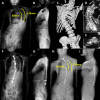The Effect of Traditional Single Growing Rod Technique on the Growth of Unsegmented Levels in Mixed-Type Congenital Scoliosis
- PMID: 33203246
- PMCID: PMC9344510
- DOI: 10.1177/2192568220972080
The Effect of Traditional Single Growing Rod Technique on the Growth of Unsegmented Levels in Mixed-Type Congenital Scoliosis
Abstract
Study design: Retrospective case series.
Objectives: To present outcomes concerning patients with early-onset mixed-type congenital scoliosis (EOMTCS) treated with the traditional single growing rod (TSGR), focusing on the growth of unsegmented levels (USLs).
Methods: Patients with EOMTCS who underwent TSGR and had a minimum of 4 USLs, 4 distractions, and 3-year follow-up were enrolled. Spine radiographs before and after index surgery and at the latest follow-up were evaluated. The length of the concave and convex side of USLs and thoracic parameters were measured. The absolute value and percentage of growth were calculated.
Results: Fourteen patients (mean age, 7.3 ± 2.8 years) were enrolled. The average follow-up duration was 4.9 ± 1.2 years, during which time 84 distractions and 8 final fusions were performed. The average number of USLs was 6.3 ± 2.2. The total and annual percent growth of concave side of USLs was significantly higher than convex side (32.2 ± 13.3% vs. 23.9 ± 9.5%, p = 0.007; 6.8 ± 2.7%/year vs. 5.1% ± 2.2%/year, p = 0.007, respectively). The concave-to-convex ratio of USLs increased from 58.6 ± 6.4 ± 7.6% at baseline to 68.8 ± 9.3% at the latest follow-up (p < 0.001). The Campbell's space available for lung ratio increased from 74.9 ± 11.1% at baseline to 89.6 ± 7.0% at the latest follow-up (p < 0.001).
Conclusions: In patients with EOMTCS, unilateral repetitive lengthening with TSGR can accelerate the growth of the concave side of USLs and improve the symmetry of the thorax.
Keywords: failure of segmentation; mixed-type congenital scoliosis; single growing rod; spinal growth.
Conflict of interest statement
Figures



Similar articles
-
Growth of the thoracic spine in congenital scoliosis after expansion thoracoplasty.J Bone Joint Surg Am. 2003 Mar;85(3):409-20. doi: 10.2106/00004623-200303000-00002. J Bone Joint Surg Am. 2003. PMID: 12637424
-
Expansion thoracoplasty: the surgical technique of opening-wedge thoracostomy. Surgical technique.J Bone Joint Surg Am. 2004 Mar;86-A Suppl 1:51-64. J Bone Joint Surg Am. 2004. PMID: 14996922
-
Single distraction-rod constructs in severe early-onset scoliosis: Indications and outcomes.Spine J. 2022 Feb;22(2):305-312. doi: 10.1016/j.spinee.2021.09.004. Epub 2021 Sep 20. Spine J. 2022. PMID: 34547389
-
The effect of opening wedge thoracostomy on thoracic insufficiency syndrome associated with fused ribs and congenital scoliosis.J Bone Joint Surg Am. 2004 Aug;86(8):1659-74. doi: 10.2106/00004623-200408000-00009. J Bone Joint Surg Am. 2004. PMID: 15292413
-
Convex Instrumented Hemiepiphysiodesis With Concave Distraction: A Treatment Option for Long Sweeping Congenital Curves.J Pediatr Orthop. 2016 Apr-May;36(3):226-31. doi: 10.1097/BPO.0000000000000441. J Pediatr Orthop. 2016. PMID: 25812144
Cited by
-
Local contamination is a major cause of early deep wound infections following open posterior lumbosacral fusions.Spine Deform. 2023 Sep;11(5):1209-1221. doi: 10.1007/s43390-023-00694-x. Epub 2023 May 5. Spine Deform. 2023. PMID: 37147477
References
-
- Hensinger RN. Congenital scoliosis: etiology and associations. Spine (Phila Pa 1976). 2009;34(17):1745–1750. doi:10.1097/BRS.0b013e3181abf69e - PubMed
-
- Williams BA, Matsumoto H, McCalla DJ, et al. Development and initial validation of the Classification of Early-Onset Scoliosis (C-EOS). J Bone Joint Surg Am. 2014;96(16):1359–1367. doi:10.2106/JBJS.M.00253 - PubMed
-
- Pahys JM, Guille JT. What’s new in congenital scoliosis? J Pediatr Orthop. 2018;38(3):e172–e179. doi:10.1097/BPO.0000000000000922 - PubMed
-
- Lonstein JE. Long-term outcome of early fusions for congenital scoliosis. Spine Deform. 2018;6(5):552–559. doi:10.1016/j.jspd.2018.02.003 - PubMed
-
- Yang S, Andras LM, Redding GJ, Skaggs DL. Early-onset scoliosis: a review of history, current treatment, and future directions. Pediatrics. 2016;137(1):e20150709. doi:10.1542/peds.2015-0709 - PubMed
LinkOut - more resources
Full Text Sources

